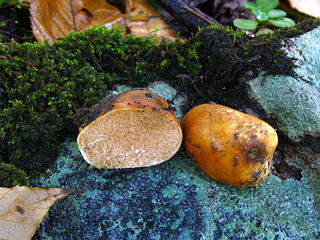
The Russulaceae are a diverse family of fungi in the order Russulales, with roughly 1,900 known species and a worldwide distribution. They comprise the brittlegills and the milk-caps, well-known mushroom-forming fungi that include some edible species. These gilled mushrooms are characterised by the brittle flesh of their fruitbodies.

Lactarius is a genus of mushroom-producing, ectomycorrhizal fungi, containing several edible species. The species of the genus, commonly known as milk-caps, are characterized by the milky fluid ("latex") they exude when cut or damaged. Like the closely related genus Russula, their flesh has a distinctive brittle consistency. It is a large genus with over 500 known species, mainly distributed in the Northern hemisphere. Recently, the genus Lactifluus has been separated from Lactarius based on molecular phylogenetic evidence.

Milk-cap is a common name that refers to mushroom-forming fungi of the genera Lactarius, Lactifluus, and Multifurca, all in the family Russulaceae. The common and eponymous feature of their fruitbodies is the latex ("milk") they exude when cut or bruised. Mushrooms with typical milk-cap characteristics are said to have a lactarioid habit. Some of them are edible.

Lactifluus volemus, formerly known as Lactarius volemus, and commonly known as the weeping milk cap or bradley, is a species of fungus in the family Russulaceae. It is widely distributed in the northern hemisphere, in temperate regions of Europe, North America and Asia as well as some subtropical and tropical regions of Central America and Asia. A mycorrhizal fungus, its fruit bodies grow on the ground at the base of various species of trees from summer to autumn, either individually or in groups. It is valued as an edible mushroom, and is sold in markets in Asia. Several other Lactifluus mushrooms resemble L. volemus, such as the closely related edible species L. corrugis, but these can be distinguished by differences in distribution, visible morphology, and microscopic characteristics. L. volemus produces a white spore print and has roughly spherical spores about 7–8 micrometres in diameter.

Zelleromyces is a genus of fungi in the family Russulaceae. It was first described by mycologists Rolf Singer and Alexander H. Smith in 1960 to contain hypogeous (underground) fungi with gasteroid fruit bodies that "bleed" latex when they are cut.

Lactifluus deceptivus, commonly known as the deceiving milkcap, is a common species of fungus in the family Russulaceae.

Lactifluus corrugis, commonly known as the corrugated-cap milky, is an edible species of fungus in the family Russulaceae. It was first described by American mycologist Charles Horton Peck in 1880.

Lactifluus is one of three genera of mushroom-forming fungi containing species commonly named "milk-caps", the others being Lactarius and Multifurca. It has been separated from Lactarius based on molecular phylogenetic evidence but is very similar to that genus. There are roughly 150 known Lactifluus species, which have a mainly tropical distribution but are also found in the north temperate zone and Australasia. Some of them are edible mushrooms.
Lactifluus heimii is a species of agaric fungus in the family Russulaceae. It is found in Burundi, where it grows in miombo woodland dominated by Bracystegia utilis.
Lactifluus edulis is a species of agaric fungus in the family Russulaceae. Described as new to science in 1994, it is found in Burundi.
Lactifluus densifolius is a species of agaric fungus in the family Russulaceae. It is found in Zambia, where it grows in miombo woodland.

Lactifluus clarkeae, formerly known as Lactarius clarkeae, is a species of mushroom-forming fungus in the family Russulaceae. It is found in Australia and New Zealand in mycorrhizal association with species of Nothofagus and the family Myrtaceae.
Dr Teresa Lebel is a taxonomist and ecologist who works on fungi, with a particular interest in subterranean truffle-like fungi and their mushroom, bolete, bracket or cup relatives.
Lactifluus jetiae is a species of mushroom-forming fungus in the family Russulaceae. It was described by Luke Vaughan, Lachlan Tegart, James K. Douch, and Teresa Lebel in 2021. The specific epithet is a Latinisation of the initials JET, in honour of Jennifer E. Tonkin, who had collected and preliminarily analysed many Australian members of the Russulaceae. The type locality is near the Cann River, Australia.
Lactifluus pagodicystidiatus is a species of mushroom in the family Russulaceae. It was described by Luke Vaughan, Lachlan Tegart, and James K. Douch in 2021. The specific epithet refers to the presence of some cystidia with shapes resembling a pagoda. The type locality is near the summit of Mount Jersey, Australia.
Lactifluus rugulostipitatus is a species of mushroom in the family Russulaceae. It was described by James K. Douch, Lachlan Tegart, Luke Vaughan, and Teresa Lebel in 2021. The specific epithet refers to the longitudinally wrinkled stipe that is characteristic of this species. The type locality is near Mount Bundey, Australia.
Lactifluus albens is a species of mushroom in the family Russulaceae. It was described by Teresa Lebel, James K. Douch, and Luke Vaughan in 2021. The specific epithet is Latin (bleached), named for the pale cream to buff colouration of basidiomata. The type locality is Dwellingup, Australia.
Lactifluus psammophilus is a species of mushroom in the family Russulaceae. It was described by Teresa Lebel, James K. Douch, and Luke Vaughan in 2021. The specific epithet is Latin (sand-loving), referring to this species' habitat. The type locality is Bunyip State Park, Australia.
Lactifluus pseudoflocktoniae is a species of mushroom in the family Russulaceae. It was described by Teresa Lebel, James K. Douch, Lachlan Tegart, and Luke Vaughan in 2021. The specific epithet refers to Lactifluus flocktoniae, to which this species has a strong resemblance. The type locality is near Cann River, Australia.









